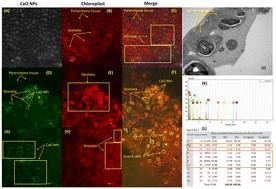当前位置:
X-MOL 学术
›
Environ. Sci.: Nano
›
论文详情
Our official English website, www.x-mol.net, welcomes your feedback! (Note: you will need to create a separate account there.)
Unravelling mechanisms of CaO nanoparticle-induced drought tolerance in Brassica napus: an analysis of metabolite and nutrient profiling
Environmental Science: Nano ( IF 7.3 ) Pub Date : 2024-05-01 , DOI: 10.1039/d4en00080c Ahsan Ayyaz 1 , Iram Batool 1 , Kangni Zhang 1 , Fakhir Hannan 1 , Yongqi Sun 1 , Tongjun Qin 1 , Habib-ur-Rehman Athar 2 , Zafar Ullah Zafar 2 , Muhammad Ahsan Farooq 1 , Weijun Zhou 1
Environmental Science: Nano ( IF 7.3 ) Pub Date : 2024-05-01 , DOI: 10.1039/d4en00080c Ahsan Ayyaz 1 , Iram Batool 1 , Kangni Zhang 1 , Fakhir Hannan 1 , Yongqi Sun 1 , Tongjun Qin 1 , Habib-ur-Rehman Athar 2 , Zafar Ullah Zafar 2 , Muhammad Ahsan Farooq 1 , Weijun Zhou 1
Affiliation

|
Nanotechnology has been widely used in agriculture to improve plant growth and stress tolerance. The exogenous application of calcium nanoparticles (CaO NPs) can improve plant tolerance to drought stress. However, the underlying physiological molecular mechanisms are still unclear. Herein, 100 mg L−1 of CaO NPs were applied to rapeseed plants when grown under the conditions of 0–15% w/v PEG-6000 solution. Drought stress reduced the rapeseed growth, CO2 assimilation rate, stomatal conductance, and photosynthetic pigments. The application of 100 mg L−1 CaO NPs improved the growth of rapeseed plants under drought conditions (shoot dry weight, 77%; root dry weight, 69%). Growth improvement due to CaO NPs was positively associated with the photosynthetic rate, quantum yield of photosystem II and quantity of photosynthetic pigments. The net photosynthetic rate (Pn), stomatal conductance (Gs), internal CO2 (Ci), and transpiration rate (Tr) increased by 65%, 85%, 69%, and 67%, respectively. The increases in quantum yield of photosystem II and photosynthetic pigments due to CaO NPs were 85% and 53%, respectively. A positive association between the growth and each of the gas exchange attributes, PSII activity and photosynthetic pigments indicated that CaO NPs improved the photosynthetic rate by reducing stomatal, as well as non-stomatal, limiting factors. The CaO NP treatment also improved the uptake of mineral nutrients under drought stress, including calcium by 82%, and potassium, phosphorous, magnesium, manganese, and boron by 78%, 89%, 72%, 80% and 73%, respectively. Furthermore, the application of CaO NPs caused a greater accumulation of 28 metabolites and reduced the accumulation of 18 metabolites that are mainly related to N-metabolism and amino acid biosynthesis, such as cysteine/homocysteine, lysine, tryptophan, alanine, glutamate, and proline, compared to droughted plants. The application of CaO NPs under drought conditions induced the up-regulation of upstream genes such as CHS, CHI, F3′H, and F3H, early development genes such as PAL, C4H, 4CL1, 4CL5, DFR, and ANS, and late development genes such as UGT78D2, UGT79B1, MT, PAP1, and PAP2 in plants involved in flavonoid biosynthesis expression. The findings of this study suggest that CaO NPs improved the photosynthetic capacity through modulating the stomatal conductance, photosystem II activity, accumulation of nutrients, and reprogramming of both primary and secondary metabolic pathways such as N-metabolism, hormonal and flavonoid biosynthesis for regulating rapeseed growth under drought stress.
中文翻译:

揭示 CaO 纳米颗粒诱导甘蓝型油菜耐旱性的机制:代谢物和营养成分分析
纳米技术已广泛应用于农业,以改善植物生长和抗逆性。外源施用纳米钙(CaO NPs)可以提高植物对干旱胁迫的耐受性。然而,潜在的生理分子机制仍不清楚。在此,将100 mg L -1的CaO NPs施用于在0-15%w/v PEG-6000溶液条件下生长的油菜植物。干旱胁迫降低了油菜籽的生长、CO 2同化率、气孔导度和光合色素。施用100 mg L -1 CaO NPs改善了干旱条件下油菜植株的生长(地上部干重,77%;根干重,69%)。 CaO NPs 带来的生长改善与光合速率、光系统 II 的量子产率和光合色素的数量呈正相关。净光合速率(Pn)、气孔导度(Gs)、内部CO 2 (Ci)和蒸腾速率(Tr)分别增加65%、85%、69%和67%。 CaO NPs 导致光系统 II 和光合色素的量子产率分别增加了 85% 和 53%。生长与气体交换属性、PSII 活性和光合色素之间的正相关表明,CaO NPs 通过减少气孔和非气孔限制因素来提高光合速率。 CaO NP处理还提高了干旱胁迫下矿质养分的吸收,其中钙提高了82%,钾、磷、镁、锰和硼分别提高了78%、89%、72%、80%和73%。此外,CaO NPs的应用导致28种代谢物的积累增加,并减少了18种主要与N代谢和氨基酸生物合成相关的代谢物的积累,如半胱氨酸/高半胱氨酸、赖氨酸、色氨酸、丙氨酸、谷氨酸和脯氨酸,与干旱植物相比。干旱条件下CaO NPs的施用诱导了CHS、CHI、F3'H和F3H等上游基因以及PAL、C4H、4CL1、4CL5、DFR和ANS等早期发育基因以及晚期发育基因的上调。基因如UGT78D2、UGT79B1、MT、PAP1和PAP2在参与类黄酮生物合成表达的植物中。本研究的结果表明,CaO NPs 通过调节气孔导度、光系统 II 活性、养分积累以及重新编程初级和次级代谢途径(如氮代谢、激素和类黄酮生物合成)来调节油菜生长,从而提高光合能力在干旱胁迫下。
更新日期:2024-05-01
中文翻译:

揭示 CaO 纳米颗粒诱导甘蓝型油菜耐旱性的机制:代谢物和营养成分分析
纳米技术已广泛应用于农业,以改善植物生长和抗逆性。外源施用纳米钙(CaO NPs)可以提高植物对干旱胁迫的耐受性。然而,潜在的生理分子机制仍不清楚。在此,将100 mg L -1的CaO NPs施用于在0-15%w/v PEG-6000溶液条件下生长的油菜植物。干旱胁迫降低了油菜籽的生长、CO 2同化率、气孔导度和光合色素。施用100 mg L -1 CaO NPs改善了干旱条件下油菜植株的生长(地上部干重,77%;根干重,69%)。 CaO NPs 带来的生长改善与光合速率、光系统 II 的量子产率和光合色素的数量呈正相关。净光合速率(Pn)、气孔导度(Gs)、内部CO 2 (Ci)和蒸腾速率(Tr)分别增加65%、85%、69%和67%。 CaO NPs 导致光系统 II 和光合色素的量子产率分别增加了 85% 和 53%。生长与气体交换属性、PSII 活性和光合色素之间的正相关表明,CaO NPs 通过减少气孔和非气孔限制因素来提高光合速率。 CaO NP处理还提高了干旱胁迫下矿质养分的吸收,其中钙提高了82%,钾、磷、镁、锰和硼分别提高了78%、89%、72%、80%和73%。此外,CaO NPs的应用导致28种代谢物的积累增加,并减少了18种主要与N代谢和氨基酸生物合成相关的代谢物的积累,如半胱氨酸/高半胱氨酸、赖氨酸、色氨酸、丙氨酸、谷氨酸和脯氨酸,与干旱植物相比。干旱条件下CaO NPs的施用诱导了CHS、CHI、F3'H和F3H等上游基因以及PAL、C4H、4CL1、4CL5、DFR和ANS等早期发育基因以及晚期发育基因的上调。基因如UGT78D2、UGT79B1、MT、PAP1和PAP2在参与类黄酮生物合成表达的植物中。本研究的结果表明,CaO NPs 通过调节气孔导度、光系统 II 活性、养分积累以及重新编程初级和次级代谢途径(如氮代谢、激素和类黄酮生物合成)来调节油菜生长,从而提高光合能力在干旱胁迫下。































 京公网安备 11010802027423号
京公网安备 11010802027423号